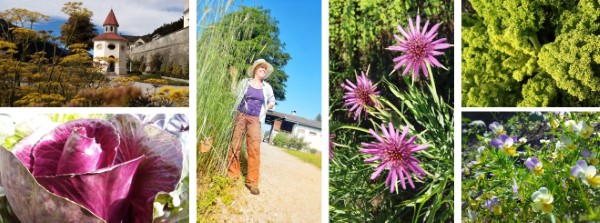
An alpine monastry garden

An alpine monastry garden * by Simone Matouch, October 2020
Being involved in the restoration of the historic alpine monastery garden in Maria Luggau (Lesachtal, Carinthia, AT) was exciting and a fulfilling task from the beginning. Being an expert in herbal medicine I was asked by the municipality to plan the planting, to take care of the maintenance of the garden, develop a concept for garden tours and organise the processing of herbs.
Activities started in 2012, the garden re-opened in 2013 and from the beginning I was fascinated by the fact that this offers the opportunity for creating a garden as an herbal pharmacy. Although since several years now there is a real hype und revival of herbal knowledge it seems to me to be a fleeting trend - Many people seem to be unaware of the great importance such a garden can have.
The COVID crisis and even more the climate and biodiversity crisis make me aware that such a herbal garden is a real treasure – as a source for immune-strengthening plants but even more as a proper pharmacy in case the supply structures collapse for a longer period. I know that this may be thinking too far ahead, but every now and then this thought comes to my mind.
This year the first gardening works have coincided with the lockdown in Austria. No visitors in the garden – what is normal for that time of the year before the start of the tourist season in May. So, I could go there being on the sure side not to meet anybody and not violate the lockdown rules. I felt graceful having the option to move a bit and get outside - in a garden and follow the work that has to be done when spring comes. Nature goes its own way, lockdown or not.
At the same time, I felt sadly what was missing: the interaction with other people! Winter and especially the early spring are a quite quiet period of the year in this remote alpine valley. When the meadows and fields get rid of the snow it is also time for people to come together again and awaken to new life. You normally meet people outside their houses whom you did not meet for the whole dark season. People seem starved of social contact but now the slogan is social distancing. The garden work at least allows some large physical distance communication with some others doing their outdoor work that has to be done.

Less sadly I realised what else was missing. The absolute quietness made me aware of the normal noise pollution that one actively no longer perceives. I was especially amazed about how deeply I felt the disappearance of the air traffic.
Apart from growing medicinal and aromatic herbs from the beginning the planting of cereals and vegetables is an integral part of the monastery garden management. There are historical reasons for this - in a monastery garden there were always these 3 areas: a part for the food supply, an orchard and an herb garden. But for nowadays it is also a great opportunity to plant and propagate old seeds varieties – from seed banks as Arche Noah or ReinSaat as well as old local varieties. These plants - be it buckwheat, black emmer, fibre hemp but even onion or garlic are often a cause for amazement and discussion, sometimes a trigger for memories of earlier times among the older visitors to the garden. More and more often visitors are amazed at the good growth of the plants here, mainly having in mind the droughts in their home countries, which are drying up all growth. This year the fleeting encounters and conversations are interspersed with other thoughtful tones - what will the future bring, especially in times of Corona?
We had a good tourist season in 2020, a bit like the island of the blessed… - and enough water which is due to the enormous wet snow event we had last November causing again some great damage to the forests. Together with most other actors in the field of tourism and agriculture I share the feeling of great relief and thankfulness that Corona did not cause a collapse neither in health nor economy. My garden work is nearly finished for this year. From year to year I find it harder to recognise the end of the growing season. It is an end, an incision where at the same time you do not know what the next year will bring.
The head is already full of new ideas to bring more diversity into the garden, new seed varieties to test and new products to process. Hopefully they will grow as seeds do over the winter down in the earth.
